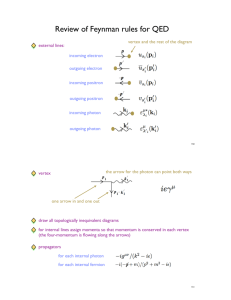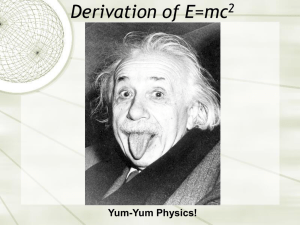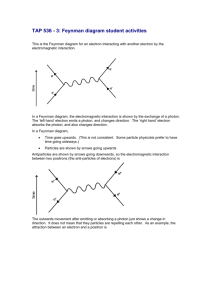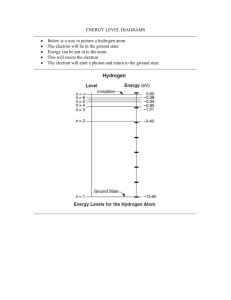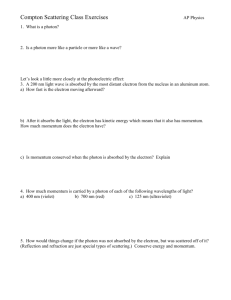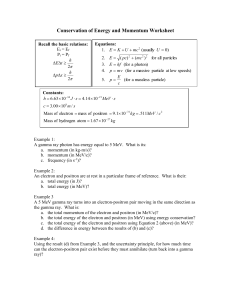lecturenotes2012_19
advertisement
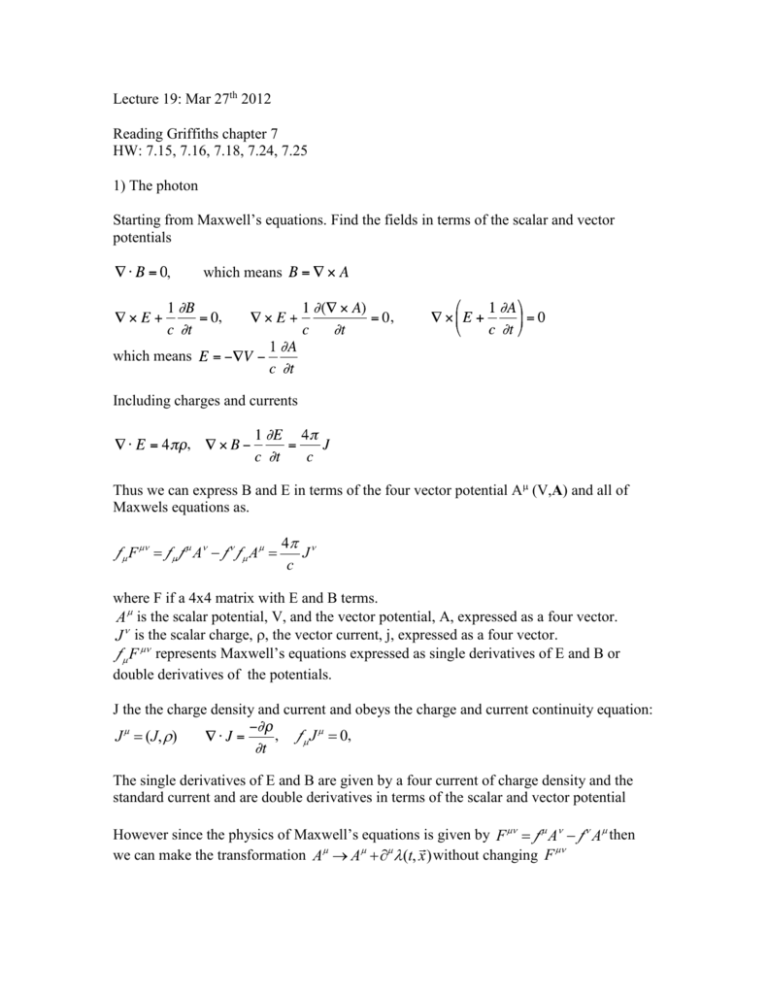
Lecture 19: Mar 27th 2012 Reading Griffiths chapter 7 HW: 7.15, 7.16, 7.18, 7.24, 7.25 1) The photon Starting from Maxwell’s equations. Find the fields in terms of the scalar and vector potentials , which means , , which means Including charges and currents , Thus we can express B and E in terms of the four vector potential A (V,A) and all of Maxwels equations as. ¶m F mn = ¶m¶ m An - ¶ n¶m Am = 4p n J c where F if a 4x4 matrix with E and B terms. A m is the scalar potential, V, and the vector potential, A, expressed as a four vector. J n is the scalar charge, , the vector current, j, expressed as a four vector. ¶m F mn represents Maxwell’s equations expressed as single derivatives of E and B or double derivatives of the potentials. J the the charge density and current and obeys the charge and current continuity equation: J m = (J, r) , ¶m J m = 0, The single derivatives of E and B are given by a four current of charge density and the standard current and are double derivatives in terms of the scalar and vector potential However since the physics of Maxwell’s equations is given by F mn = ¶ m An - ¶ n Am then we can make the transformation Am ® Am +¶m l (t, x) without changing F mn Consider a case where we use gauge freedom to set ¶m A m = 0 and there is no four current i.e. no charges. Then ¶m F mn = ¶m¶ m An - ¶ n¶m Am = ¶m¶ m An = boxAm = 4p n J = 0 , box = c This is the Maxwell’s equation for a photon and we also recognize it as the Klein-Gordon equation for a massless particle box A =0, , However, this time we must consider the more general case of four vector solutions. This will allow for particles with spin. Borrowing from previous solutions An (x) = ae -(i / )x m p m n e (p) Plugging into the gauge condition gives p mem = 0 Which can be solved with: e1 = (0,1,0,0), and e1 = (0,0,1,0) for a particle traveling in the z direction. This is appropriate for the photon which can have spin oriented along it’s direction of motion of opposite. Spin projection 1 or -1 2) Electromagnetic interaction via a potential Now consider the case with a charges so that J is not zero : ¶m¶ m An = 4p n J c A is the potential caused by charges and currents. If we have an electron in this potential will feel a force proportional to E and B times the charge(and velocity) of the electron or in terms of A, e times derivatives of A. Another way to think of this is that a force will cause a change in momentum F = dp/dt. Integrating to find the total change Dp = ò F = e ò ¶A µ eA Therefore p ® p + eA . Quantizing i¶ m ® i¶ m +eA m This is how you insert the effect of the potential in the wave equation. In a more rigorous mathematical sense this forming what is known as the covariant derivative can be shown to enforce gauge invariance in the Lagrangian. For simplicity let’s consider the effect on a massive scalar particles satisfying the KleinGordan equation. (¶m¶ m + m 2 - ie(¶m A m + Am¶ m ) - e 2 A2 )f = 0 The A2 term can be identified as the energy of the potential. Note that this gives the expected form of e times derivatives of A. Now if we treat this in perturbation theory then we can say we have a base wave equation and electromagnetic perturbation potential, V, that can change initial states to final states. V = -ie(¶m Am + Am¶ m ) - e 2 A2 3) T: The transition rate from an initial to a final state. Neglecting spin. T = -i ò f *f V fi d 4 x Where the A2 part of V will not contribute since it’s a constant and can not convert initial to final states. T = -e ò f *f ((¶m A m + Am¶ m ))fi d 4 x integrating by parts ò f ¶m A m f d * f i ( 4 x = - ò (¶mf *f ) A mfi and ) T = -e ò f *f (¶mfi ) - (¶mf *f )fi A m d 4 x then for Klein-Gordon equation solutions: f = Ne-ip× x T = -ieNi N f ò ( p + p )m e i i( p f -pi )×x f Am d 4 x A the potential and represents the photon and eNi N f ( pi + p f ) e m Consider Maxwell’s equation for A. ¶m¶ m An = i( p f -pi )×x one particle 4p n J c Considering that the potential is caused by the second particle a possible solution for J is J n = eN i2N f 2 ( pi2 + p f 2 ) e n i( p i 2 - p f 2 )×x We already have a form of the solution for A in free space. Lets use that form to find a solution for a virtual or propagator form of A. Plugging in the Klein-Gordon equation solution for A An = Ne-iq× xen (q), q=pf2-pi2 T = -i ò J1m 1 m2 4 J d x q2 The integrate out the exponentials over space which forces q = pf2-pi2 = pi1-pf1 mæg ö n T = -iN ie ( pi1 + p f 1 ) ç mn2 ÷ ie ( pi2 + p f 2 ) (2)44 (pi1 + pi2 - pf1 - pf2) èq ø This is the form of the matrix element in EM theory. Very similar to our toy theory except that there are the momentum terms. Recall that in the toy theory we found that for units to work out the coupling constants had to have units of momentum. Now that unit of momentum is explicitly in the form and we have an identical propagator to the one we used for the toy theory for a massless propagator. 4) Wave equation solutions review Free electrons and positron solutions Electron: y(x) = e-(i / )p× x s u ( p) Positron: y(x) = e(i / n s ( p),where s =1,2 spins )p×x Also define the adjoint: u = u+0, and u = +0 and u iuj = 2mij, u ij = -2mij i,j = 1,2 spins us u s = kpk + m, s u s = kpk – m, summed over s = 1,2 spins Note that in the last equation the multiplication is backward, column times row, which results in a 4x4 matrix as in the solution Free photon solutions Photon: An = Ne-iq× xe s,n (q), where s = 1,2 polarizations One possible solution for e: e1,n = (0,1,0,0) and e 2,n = (0,0,1,0), with spins oriented along z. Photon propagator solution in a 1/q2 form: -ig/q2 Electron propagator solution: i(q + m)/(q2 - m2) From sum over electron ket-bra wave functions The current terms in a form u sf (p f )igeg m usi (pi ) The gamma matrix placed between wave functions explicitly includes the vector nature of the interaction. We also place the factor that represents the strength of the interaction here. The evaluation of the initial and final state terms will give us the factor of momentum that we derived from transition rate above while the u spinors will encode the spin information and enforce conservation of spin and all other quantum numbers that the spinors can be Eigenfunctions of . 5) Feynman rules for iM a) Draw a diagram labeling all the incoming and outgoing momentum and spins. Use arrows to indicate particles (with direction of time) and antiparticles (opposite direction of time) and internal lines (preserving continuity of the direction of flow). Note down which spins are known and which will be summed over (final or internal state spins) or averaged over (initial state spins if unknown). b) Write down spinors for particles and antiparticles. u for incoming electrons and u for outgoing electrons. u for incoming positrons and for outgoing positrons. e m for incoming photons and e m * for outgoing photons. For instance for an incoming electron, s3 1, we write us1 (p1 ) and for an outgoing electron, 3, u ( p3 ) c) Vertex factors of ige, use a different index for each term. The vertex factor is usually written between the outgoing (first) and incoming (last) particle to form a current term. s3 b and c form the current terms, example u ( p3 ) us1 (p1 ), which will reduce to factors proportional to momentum just as in our scalar particle transition rate. This is the basic unit for a particle in transition and is called a particle current, i.e. the J we derived. Where there is an initial or final state photon at the vertex the vertex factor will be summed over with the photon if there is one. e m = e/ . Each vertex represents a separate interaction and has its own index d) Propagators for the photons or electrons/positrons: -ig/q2, i(q + m)/(q2 - m2) Note in the photon propagator case the g matrix converts to so it is summed with of the second current. The propegator is what relates the two interactions in this case. In the case of the electron propagator the each current had a photon which is summed with the of the vertex and the propagator has it’s own sum over q, so no further sums have to be done to get a scalar result for the matrix element probability. q is often written as q/ e) Add an integral over the internal four momentum d4q/(2)4 and a four dimensional delta function for each vertex and use one to integrate over the internal four momentum and cancel the other since it corresponds to overall four momentum conservation. f) antisymmetrization. Crossed diagrams will exist for identical sets of particles in the final state. The second diagram will get a negative sign (Fermi statistics). Since diagrams can have their electrons moved from the initial to the final state where they occur as a positron producing an equivalent in probability diagram (crossing symmetry), you need to add a negative sign for diagrams that have an incoming electron and an outgoing positron or vice-versa also. 6) Examples: Electron-electron scattering: Standard diagram and crossed diagram -iM = ò u s3 ( p3 )igeg m us1( p1) igmn q2 u s4 ( p4 )ige g n u s2 ( p2 )(2p ) d 4 ( p1 - p3 - q)(2p ) d 4 ( p2 + q - p4 ) 4 4 d 4q (2p ) 4 and a crossed diagram terms with a negative sign ig d 4q 4 4 4 4 s3 n s2 -iM = - ò u s4 ( p4 )ige g m u s1( p1) mn u ( p )ig g u ( p ) 2 p d p p q 2 p d p + q p ( ) ( ) ( ) ( ) 3 e 2 1 4 2 3 4 q2 (2p ) Use the integration over one delta function to evaluate q. Cancel the other one. Considering the case where we start with un-polarized electrons, we can drop the spin labels and remember that we will have to average over the initial states and sum over the final states in the end. M= -ge2 ( p1 - p3 ) m 2 [ u (3)g u(1)][ u (4)g m u(2)] + ge2 ( p1 - p4 ) 2 [ u(3)g m u(2)][ u (4)g m u(1)] Electron positron scattering: Standard diagram and annihilation diagram. Now that we are used to the form of the matrix element we can skip straight to the second step. M= -ge2 ( p1 + p2 ) m 2 [n (2)g u(1)][ u (3)g mn (4)] + ge2 ( p1 - p3 ) 2 [ u(3)g m u(1)][n (2)g mn (4)] Note that in the first term the current electron to positron involves only initial or final state particles respectively. When writing down the terms we always put the adjoint term of the current first so that when multiplied by other term you get a scalar probability.

